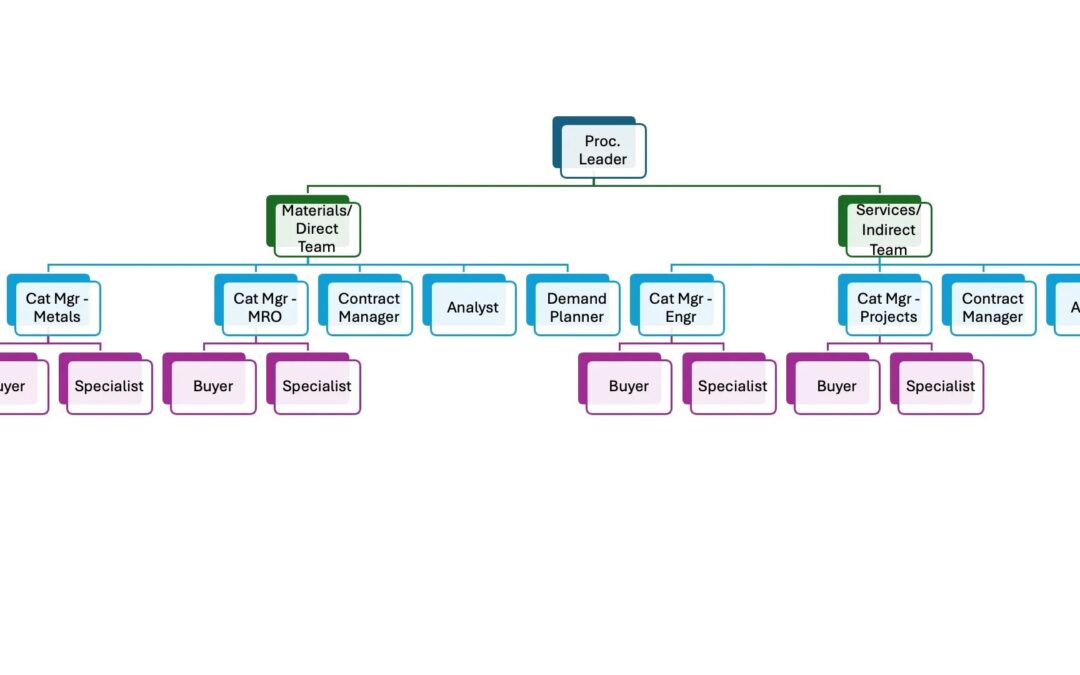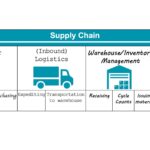We’ve been talking about supply chain structure and reporting chains recently, so let’s chat a little about front-line procurement roles. Today we’ll talk about role descriptions, and also talk about staffing levels needed when building/rebuilding/reevaluating a team.
Role Descriptions
When searching Indeed for supply chain roles, I found a list of 18 roles. I had a couple takeaways from this search result:
- These roles are largely focused on logistics and warehouse roles, less on procurement roles.
- A surprising number of these roles are vulnerable to replacement by AI
- Some roles are missing – most notably the Category/Commodity Management role and the Contract Manager/Administrator role.
So let’s talk about the Procurement/Purchasing roles identified by Indeed:
- Purchasing Clerk
- Buyer
- Category Analyst
- Procurement Specialist
- Demand Planner
- Supply Chain Analyst
I’m going to modify this list to add in the Category Manager and Contract Manager, as I view these roles as key components of the procurement team. I’m also combining the Supply Chain and Category Analyst roles, and the Purchasing Clerk and Procurement Specialist roles. While these can be distinctive, I’ve found that even in large supply chain or procurement teams they only have one or the other of these. So I’m now left with the following list of roles:
- Procurement Specialist
- Buyer
- Category Manager
- Contract Manager
- Supply Chain Analyst
- Demand Planner
The Procurement Specialist focuses on cutting purchase orders (POs), might structure or execute bids, and might follow up on POs or expedite orders.
The Buyer cuts POs and conducts bids/Requests for Proposal (RFPs).
The Category Manager sets the strategy for their categories, runs bids, and negotiates complicated supplier agreements.
The Contract Manager negotiates contracts (often with the Category Manager handling the commercial side of the agreement) and may or may not do some maintenance on contracts.
The Supply Chain Analyst pulls and creates reports, runs metrics, and may assist in analyzing complicated bid responses.
The Demand Planner interprets information from production and sales to generate the “demand signal” used by the procurement team to determine volumes and cadence of categories (note that Lora Cecere has excellent work on ensuring the path between demand planner and customer is as short as possible).
Note that the Procurement Specialist and Supply Chain Analyst are the roles most susceptible to AI, or with the highest AI opportunity, depending on your perspective. The other roles benefit from large language model AI (like ChatGPT), but in more as a support than a major labor replacement.
Staffing Levels
I’m often asked how many people should staff a procurement team, either when building or rebuilding a team. Here is the guidance I offer, generally based on spend or task activity.
- Procurement Specialists and Buyers – The staffing for each of these should be based on the number of POs and bids to be processed, the automation of that process, and the time it takes to complete those tasks. If at all possible, calculate the number of POs that must be cut manually (not blanket releases, not generated by the system), and the time it takes to cut an average PO. A time study might actually be helpful here, along with a little process mapping. Then assume people are available for 6 hours of that work per day (1500 hours/year) after meetings and supporting category managers, and calculate how many people are needed to cover the workload. Over time, this staffing might be reduced through automation and process efficiencies.
- Category Managers – the staffing for this role should be based on spend. A category manager can generally handle $100m-$150m in spend annually, but this should be tempered with the number of item numbers they handle. It is far harder to manage $100m in MRO than $100m in sheet steel spend. If you have category managers handling services, such as contractors or engineering firms or HR support services, that can also be tricky to get the staffing right from the beginning. You may have to adjust based on lessons learned over time. The typical ratio of Buyers/Procurement Specialists to Category Managers should be about 2-3:1.
- Contract Managers – An experienced Contract Manager can handle 20-30 contracts and wrap agreements annually. So to determine Contract Manager staffing, calculate either the expected number of agreements needed or the number of suppliers who make up 80% of the company’s spend (usually about 20% of the total number of suppliers) and start with assuming one agreement per supplier. If the company does many capital projects, add the number of annual capital projects started to the number of agreements needed for negotiation.
- Supply Chain Analyst and Demand Planner – These roles vary wildly based on the company, its appetite for analytics and reports, and the skillset of the Category Managers and Supply Chain Team Leader. A procurement team should have at least one analyst, and I recommend starting with one or two per major procurement “group” (Materials/Services/Direct/Indirect). Often Supply Chain Analysts end up in special projects, so the staffing levels have to be a little flexible. Demand Planners are also sometimes found in production or operations teams, so they may or may not be a part of the supply chain team.
Hopefully this guidance is helpful in determining team staffing, whether building or rebuilding a procurement team. Contact me to chat a little more about your structure and for some customized suggestions based on your business.




